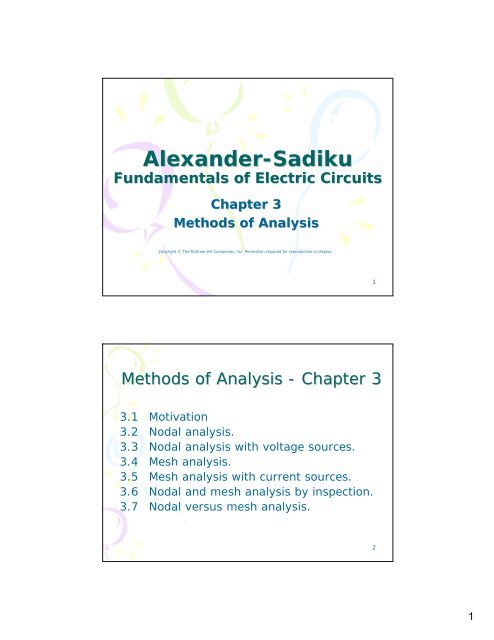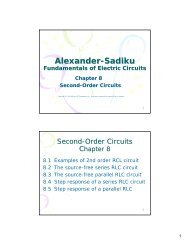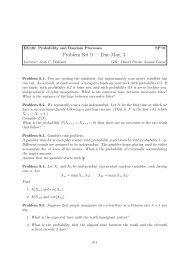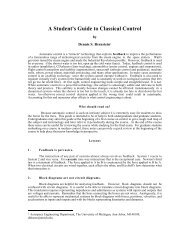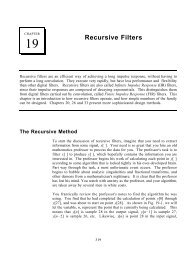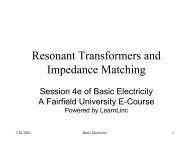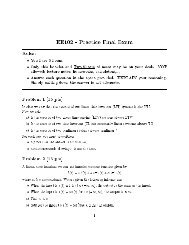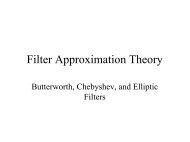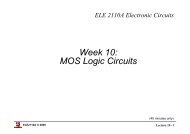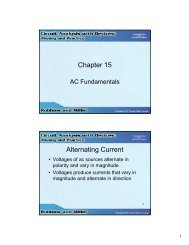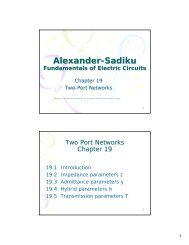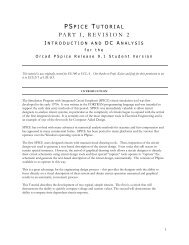Alexander-Sadiku Fundamentals of Electric Circuits Chapter 3 ...
Alexander-Sadiku Fundamentals of Electric Circuits Chapter 3 ...
Alexander-Sadiku Fundamentals of Electric Circuits Chapter 3 ...
Create successful ePaper yourself
Turn your PDF publications into a flip-book with our unique Google optimized e-Paper software.
<strong>Alexander</strong>-<strong>Sadiku</strong><br />
<strong>Fundamentals</strong> <strong>of</strong> <strong>Electric</strong> <strong>Circuits</strong><br />
<strong>Chapter</strong> 3<br />
Methods <strong>of</strong> Analysis<br />
Copyright © The McGraw-Hill Companies, Inc. Permission required for reproduction or display.<br />
1<br />
Methods <strong>of</strong> Analysis - <strong>Chapter</strong> 3<br />
3.1 Motivation<br />
3.2 Nodal analysis.<br />
3.3 Nodal analysis with voltage sources.<br />
3.4 Mesh analysis.<br />
3.5 Mesh analysis with current sources.<br />
3.6 Nodal and mesh analysis by inspection.<br />
3.7 Nodal versus mesh analysis.<br />
2<br />
1
3.1 Motivation (1)<br />
If you are given the following circuit, how can<br />
we determine (1) the voltage across each<br />
resistor, (2) current through each resistor. (3)<br />
power generated by each current source, etc.<br />
What are the things which we need to<br />
know in order to determine the answers?<br />
3<br />
Things we need to know in solving any<br />
resistive circuit with current and voltage<br />
sources only:<br />
Kirchh<strong>of</strong>f s Current Laws (KCL)<br />
Kirchh<strong>of</strong>f s Voltage Laws (KVL)<br />
Ohm s Law<br />
3.1 Motivation (2)<br />
How should we apply these laws to<br />
determine the answers?<br />
4<br />
2
3.2 Nodal Analysis (1)<br />
It provides a general procedure for analyzing circuits<br />
using node voltages as the circuit variables.<br />
Example 1<br />
3<br />
5<br />
3.2 Nodal Analysis (2)<br />
Steps to determine the node voltages:<br />
1. Select a node as the reference node.<br />
2. Assign voltages v1,v2, ,vn-1 to the<br />
remaining n-1 nodes. The voltages are<br />
referenced with respect to the<br />
reference node.<br />
3. Apply KCL to each <strong>of</strong> the n-1 non-reference<br />
nodes. Use Ohm s law to express the branch<br />
currents in terms <strong>of</strong> node voltages.<br />
4. Solve the resulting simultaneous equations<br />
to obtain the unknown node voltages.<br />
6<br />
3
3.2 Nodal Analysis (3)<br />
Example 2<br />
circuit independent current source only<br />
Apply KCl at<br />
node 1 and 2<br />
v 1 v 2<br />
3<br />
*Refer to in-class illustration, textbook, answer v 1<br />
= -2V, v 2<br />
= -14V<br />
7<br />
3.2 Nodal Analysis (4)<br />
Example 3<br />
current with dependant current source<br />
*Refer to in-class illustration, textbook,<br />
answer v 1 = 4.8V, v 2 = 2.4V, v 3 = -2.4V<br />
8<br />
4
3.3 Nodal Analysis with<br />
Voltage Source (1)<br />
Example 4<br />
circuit with independent voltage source<br />
How to handle the 2V voltage source?<br />
9<br />
3.3 Nodal Analysis with<br />
Voltage Source (2)<br />
A super-node is formed by enclosing a (dependent<br />
or independent) voltage source connected between<br />
two non-reference nodes and any elements<br />
connected in parallel with it.<br />
*Note: We analyze a circuit with super-nodes using<br />
the same three steps mentioned above except that<br />
the super-nodes are treated differently.<br />
10<br />
5
3.3 Nodal Analysis with<br />
Voltage Source (3)<br />
Basic steps:<br />
1. Take <strong>of</strong>f all voltage sources in supernodes<br />
and apply KCL to super-nodes.<br />
2. Put voltage sources back to the nodes<br />
and apply KVL to relative loops.<br />
11<br />
3.3 Nodal Analysis with<br />
Voltage Source (4)<br />
Example 5 circuit with independent voltage source<br />
Super-node => 2-i 1<br />
-i 2<br />
-7 = 0<br />
Apply KVL => v 1<br />
+2-v 2<br />
= 0<br />
12<br />
6
3.3 Nodal Analysis with<br />
Voltage Source (5)<br />
Example 6<br />
sources<br />
circuit with two independent voltage<br />
13<br />
3.3 Nodal Analysis with<br />
Voltage Source (6)<br />
Example 7<br />
sources<br />
circuit with two independent voltage<br />
-i 1<br />
-i 2<br />
+ i 3<br />
= 0 -i 3<br />
-i 5<br />
-i 4<br />
+ i 1<br />
= 0 v 1<br />
-20-v 2<br />
= 0 v 3<br />
-3v x<br />
-v 4<br />
= 0<br />
14<br />
7
3.4 Mesh Analysis (1)<br />
1. Mesh analysis provides another general<br />
procedure for analyzing circuits using mesh<br />
currents as the circuit variables.<br />
2. Nodal analysis applies KCL to find unknown<br />
voltages in a given circuit, while mesh analysis<br />
applies KVL to find unknown currents.<br />
3. A mesh is a loop which does not contain any<br />
other loops within it.<br />
15<br />
3.4 Mesh Analysis (2)<br />
Steps to determine the mesh currents:<br />
1. Assign mesh currents i 1 , i 2 , , in to the<br />
n meshes.<br />
2. Apply KCL to each <strong>of</strong> the n meshes. Use Ohm s<br />
law to express the voltages in terms <strong>of</strong> the<br />
mesh currents.<br />
3. Solve the resulting n simultaneous equations<br />
to get the mesh currents.<br />
16<br />
8
3.4 Mesh Analysis (3)<br />
Example 8<br />
circuit with independent voltage sources<br />
Note:<br />
i 1 and i 2 are mesh current (imaginative, not measurable directly)<br />
I 1 , I 2 and I 3 are branch current (real, measurable directly)<br />
I 1 = i 1 ; I 2 = i 2 ; I 3 = i 1 - i 2<br />
18<br />
*Refer to in-class illustration, textbook<br />
17<br />
3.4 Mesh Analysis (4)<br />
Example 9<br />
circuit with dependent voltage source<br />
*Refer to in-class illustration, textbook, answer I o<br />
= 1.5A<br />
9
3.5 Mesh Analysis with<br />
Current Source (1)<br />
Circuit with current source<br />
A super-mesh results when two meshes have a (dependent or<br />
independent) current source in common as shown in (a). We create<br />
a super-mesh by excluding the current source and any elements<br />
connected in series with it as shown in (b).<br />
*Refer to in-class illustration, textbook<br />
19<br />
3.5 Mesh Analysis with<br />
Current Source (2)<br />
The properties <strong>of</strong> a super-mesh:<br />
1. The current source in the super-mesh is not<br />
completely ignored; it provides the constraint<br />
equation necessary to solve for the mesh<br />
currents.<br />
2. A super-mesh has no current <strong>of</strong> its own.<br />
3. A super-mesh requires the application <strong>of</strong> both<br />
KVL and KCL.<br />
20<br />
10
3.6 Nodal and Mesh Analysis<br />
with Inspection (1)<br />
The properties <strong>of</strong> a super-mesh:<br />
1. The current source in the super-mesh is not<br />
completely ignored; it provides the constraint<br />
equation necessary to solve for the mesh<br />
currents.<br />
2. A super-mesh has no current <strong>of</strong> its own.<br />
3. A super-mesh requires the application <strong>of</strong> both<br />
KVL and KCL.<br />
21<br />
3.6 Nodal and Mesh Analysis<br />
with Inspection (2)<br />
Example 10 By inspection, write the nodal voltage equations<br />
for the circuit<br />
*Refer to in-class illustration, textbook<br />
22<br />
11
3.6 Nodal and Mesh Analysis<br />
with Inspection (3)<br />
Example 11 By inspection, write the mesh-current equations<br />
for the circuit<br />
*Refer to in-class illustration, textbook<br />
23<br />
3.7 Nodal versus Mesh<br />
Analysis (1)<br />
To select the method that results in the smaller number <strong>of</strong><br />
equations. For example:<br />
1. Choose nodal analysis for circuit with fewer nodes than<br />
meshes.<br />
*Choose mesh analysis for circuit with fewer meshes<br />
than nodes.<br />
*Networks that contain many series connected<br />
elements, voltage sources, or supermeshes are<br />
more suitable for mesh analysis.<br />
*Networks with parallel-connected elements, current<br />
sources, or supernodes are more suitable for nodal<br />
analysis.<br />
2. If node voltages are required, it may be expedient to<br />
apply nodal analysis. If branch or mesh currents are<br />
required, it may be better to use mesh analysis.<br />
24<br />
12
This document was created with Win2PDF available at http://www.daneprairie.com.<br />
The unregistered version <strong>of</strong> Win2PDF is for evaluation or non-commercial use only.


